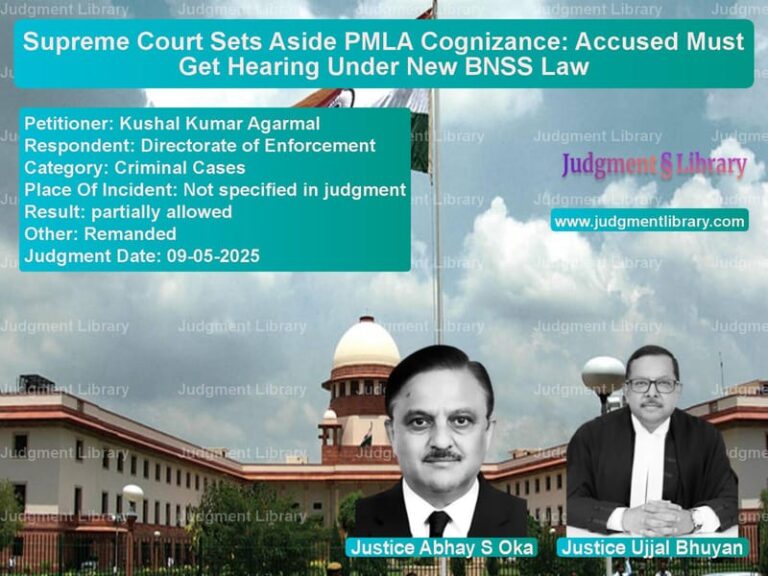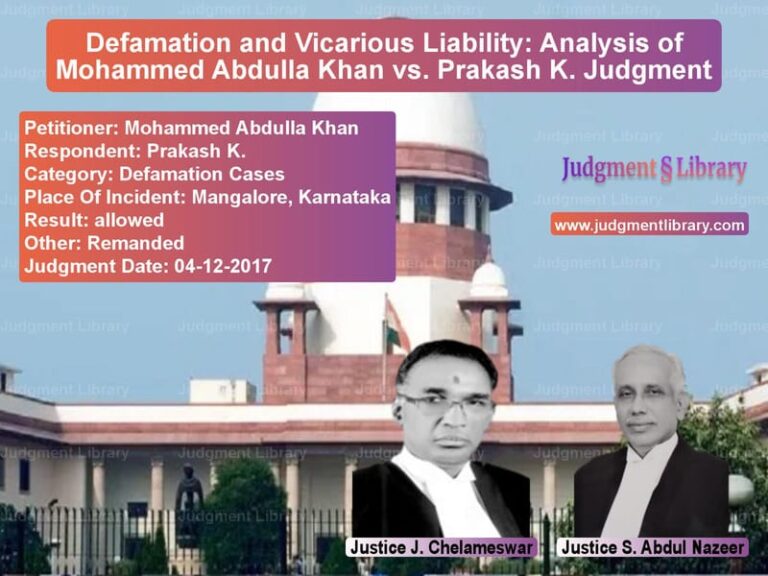Legal Interpretation of SARFAESI Act: Supreme Court Ruling on CJM’s Jurisdiction
The legal dispute in this case revolved around a crucial question concerning the interpretation of Section 14 of the Securitisation and Reconstruction of Financial Assets and Enforcement of Security Interest Act, 2002 (SARFAESI Act). The issue was whether the Chief Judicial Magistrate (CJM) has the jurisdiction to process requests from secured creditors for taking possession of secured assets under this provision. Given the conflicting rulings by various High Courts, the Supreme Court was called upon to settle the matter once and for all.
The SARFAESI Act was enacted to provide banks and financial institutions with an expedited mechanism to recover their dues from defaulters without prolonged litigation. One of the critical provisions under this law is Section 14, which allows secured creditors to seek the assistance of judicial or executive authorities to take possession of secured assets in case of default.
Background and Conflicting High Court Rulings
The matter reached the Supreme Court because different High Courts had interpreted Section 14 of the SARFAESI Act differently. Some High Courts ruled that only the Chief Metropolitan Magistrate (CMM) in metropolitan areas and the District Magistrate (DM) in non-metropolitan areas had the power to process such requests from secured creditors. Others ruled that the Chief Judicial Magistrate (CJM) could also exercise this authority.
The High Courts of Bombay, Calcutta, Madras, Madhya Pradesh, and Uttarakhand had held that only CMMs in metropolitan areas and DMs in non-metropolitan areas were competent to entertain applications under Section 14 of the SARFAESI Act. These courts emphasized a strict and literal interpretation of the statute.
On the other hand, the High Courts of Kerala, Karnataka, Allahabad, and Andhra Pradesh ruled that CJMs in non-metropolitan areas could also entertain applications under Section 14. They reasoned that CJMs perform similar functions as CMMs and should not be excluded from assisting secured creditors in recovering their dues.
Arguments by the Petitioner
The petitioner, The Authorised Officer, Indian Bank, strongly argued that the language of Section 14 of the SARFAESI Act was clear and unambiguous. They contended that:
- The legislature explicitly mentioned only CMMs and DMs in Section 14, which meant that CJMs were deliberately excluded from exercising such authority.
- A literal interpretation of the law should be followed, and the courts should not attempt to insert words into the statute that the legislature had not intended.
- Allowing CJMs to entertain such applications would create jurisdictional inconsistencies and administrative confusion.
- The interpretation allowing CJMs to entertain such requests would violate the principle of separation of powers, as the SARFAESI Act had designated specific authorities for this purpose.
Arguments by the Respondents
The respondents, including D. Visalakshi and others, argued in favor of including CJMs within the ambit of Section 14 of the SARFAESI Act. Their main contentions were:
- The functions performed by CMMs and CJMs are equivalent in their respective jurisdictions under the Criminal Procedure Code (Cr.P.C.), and there was no valid reason to exclude CJMs from exercising jurisdiction under Section 14.
- Excluding CJMs would place an undue burden on DMs in non-metropolitan areas, leading to delays in the recovery process.
- The purpose of the SARFAESI Act is to ensure a speedy and efficient recovery mechanism for banks and financial institutions. Allowing CJMs to entertain applications would facilitate this objective rather than hinder it.
- Since CJMs already handle similar administrative matters under other laws, there was no reason why they should be denied this jurisdiction under the SARFAESI Act.
Supreme Court’s Analysis and Ruling
The Supreme Court analyzed the conflicting judgments from different High Courts and examined the legislative intent behind Section 14 of the SARFAESI Act. The Court made the following key observations:
- The legislative scheme of the SARFAESI Act does not explicitly exclude CJMs from processing applications under Section 14.
- The functions of CMMs and CJMs under the Cr.P.C. are identical, and the terms are often used interchangeably in judicial practice.
- The inquiry under Section 14 of the SARFAESI Act is administrative and non-adjudicatory in nature, meaning it does not involve deciding on the rights and liabilities of parties.
- The provision is aimed at facilitating secured creditors in recovering possession of secured assets, and a restrictive interpretation would only lead to unnecessary delays.
The Supreme Court, therefore, upheld the view taken by the High Courts of Kerala, Karnataka, Allahabad, and Andhra Pradesh. It ruled that CJMs in non-metropolitan areas are competent to process applications under Section 14 of the SARFAESI Act. Consequently, the Court overturned the contrary rulings of the High Courts of Bombay, Calcutta, Madras, Madhya Pradesh, and Uttarakhand.
Impact of the Judgment
The Supreme Court’s decision has several significant implications:
- Clarity on Jurisdiction: The ruling provides much-needed clarity on the jurisdiction of CJMs in SARFAESI-related matters, ensuring uniformity in legal interpretation across India.
- Speedier Recovery for Banks: By allowing CJMs to process applications under Section 14, banks and financial institutions can recover their dues more efficiently, reducing the burden on DMs.
- Reduced Litigation: The ruling minimizes the scope for jurisdictional disputes, thereby reducing unnecessary litigation and ensuring a streamlined recovery process.
- Strengthening the SARFAESI Mechanism: The judgment reinforces the objective of the SARFAESI Act by removing obstacles in the implementation of its provisions.
Conclusion
The Supreme Court’s decision in this case has settled a long-standing legal debate regarding the competency of CJMs under Section 14 of the SARFAESI Act. By adopting a purposive interpretation of the law, the Court has ensured that the recovery process for banks and financial institutions remains efficient and effective. The ruling highlights the judiciary’s commitment to upholding legislative intent while balancing the interests of all stakeholders.
This judgment is a landmark decision that will have far-reaching implications on financial litigation and asset recovery proceedings across India.
Petitioner Name: The Authorised Officer, Indian Bank.Respondent Name: D. Visalakshi and Anr..Judgment By: Justice A.M. Khanwilkar, Justice Dinesh Maheshwari.Place Of Incident: India.Judgment Date: 23-09-2019.
Don’t miss out on the full details! Download the complete judgment in PDF format below and gain valuable insights instantly!
Download Judgment: The Authorised Offic vs D. Visalakshi and An Supreme Court of India Judgment Dated 23-09-2019.pdf
Direct Downlaod Judgment: Direct downlaod this Judgment
See all petitions in Bankruptcy and Insolvency
See all petitions in Corporate Compliance
See all petitions in Company Law
See all petitions in Judgment by A M Khanwilkar
See all petitions in Judgment by Dinesh Maheshwari
See all petitions in allowed
See all petitions in supreme court of India judgments September 2019
See all petitions in 2019 judgments
See all posts in Corporate and Commercial Cases Category
See all allowed petitions in Corporate and Commercial Cases Category
See all Dismissed petitions in Corporate and Commercial Cases Category
See all partially allowed petitions in Corporate and Commercial Cases Category







